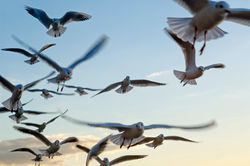Navopatia Field Station February 2025
- Bill West
- Apr 27
- 2 min read
Updated: Apr 29
An extended stay of three weeks at the Navopatia Field Station on Estero Agiabampo in southern
Sonora was a great way to start off 2025. The daily dance of the tides was the clock that ruled days. With the incoming tide, the herons, egrets, sandpipers and plovers retreated either to the mangroves or to meager cover at the high tide line. As the tide ebbed, feeding spiked as mudflats and shoals were exposed. Foraging in the deeper water were the long-legged waders such as Reddish, Snowy, and Great Egrets plus Great Blue, Little Blue, and Tricolored Herons. Shallower waters were frequented by Whimbrel, Long-billed Curlew, Marbled Godwit and Willet.
Edges were favored by Roseate Spoonbills, Western and Least Sandpipers, and Short-billed Dowitchers. The exposed muflats were scoured by Black-bellied, Semipalmated, and Wilson's Plover. The airspace above could be crowded with Caspian, Royal, Forster's, and Gull-billed Terns as well as Yellow-footed, Ring-billed, and Laughing Gulls. The latter, in large groups, provided their background chanting conversations most of the day.
Among the many fascinating behaviors we observed were the antics of the Magnificent Frigatebirds. As if suspended by an invisible puppeteer, they lazily soared above the feeding fray
below until some unlucky bird, usually a tern, made a catch and the frigatebird went into pursuit.
Dropping with sudden speed, the frigate would harry the target with stunning agility until the bird disgorged its catch which the frigate would pivot and pluck from the air before it hit the water. In addition, we watched in amazement one day as a frigate hovered low over some dolphins as they drove fish into the shallows and the frigate snatched fish from the surface. Impressive behavior from a bird that does not land on the water, much less dive into it.
The contrast between the coastscape of the estuary and adjacent pitahaya cactus forest was extreme. Desert meeting ocean is always fascinating. While watching a Verdin build its elaborate nest, an Osprey might fly by with a recently caught fish still twisting in its talons. Or a chattering Cactus Wren might be drowned out vocally by Caspian Tern overhead uttering its harsh, grating kraaa calls. Or perhaps a Crested Caracara atop a pitahaya cactus would duck as a wedge of White Ibis hurried by low enroute to their evening roost.
Sunset action of light, birds, and clouds was always entertaining. Groups of noisy grackles and cowbirds from nearby agricultural areas would gather in low trees before sunset preparing to cross the estuary enmasse to roost on the mangrove lined barrier beach. The cacophany of the flock would cease and, as if on cue, the flock of hundreds rose as one and performed its synchronized murmuration twisting and turning before agreeing on a destination for the night.
Meanwhile, lines of pelicans, gulls, terns, and cormorants would stream in all directions seeking their perfect havens for the night. And as the last light faded, the night herons and raccoons would emerge from the mangroves to do their part in round the clock foraging to the sound of Ridgeway's Rails clattering and grunting. The occasional otherworldly screech of a Barn Owl would sometimes pierce the night.
All the action would resume before sunrise with timing shifted solely by the changing of the tides




Comments